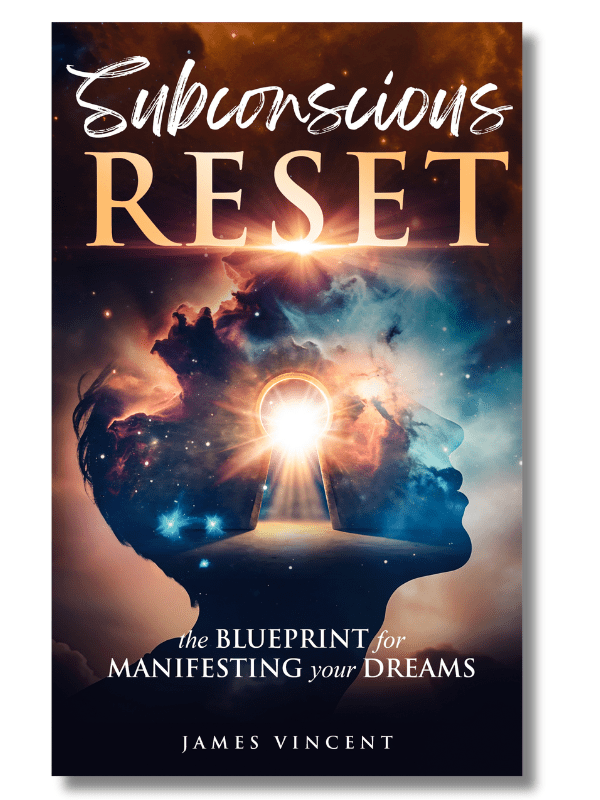Subconscious Reset
by James Vincent
Genre: Self-Help
ISBN: 9798873693939
Print Length: 102 pages
Reviewed by Erin Britton
Master your mind and achieve your dreams.
An insightful and practical guide to mastering your mind and achieving your aspirations, James Vincent’s Subconscious Reset: The Blueprint for Manifesting Your Dreams offers a richly detailed framework for making the most of your greatest resource—your brain. In an effort to help overcome the barriers that typically block self-actualization, Vincent seeks to provide “the tools to unlock your full potential and reshape your reality from the inside out.”
It’s a hugely ambitious aim for a relatively short book, but Vincent achieves much of what he sets out to do. To ensure that everyone starts on the same page (ahem ), the book begins by describing various mindsets, including the indications of which one(s) you favor. But what is a mindset? “Mindset is the mental lens through which we view the world. It shapes every thought, every decision, and every interaction, both in our personal lives and in our professional environments.”
According to Vincent, “Understanding your mindset is the cornerstone of personal transformation and a crucial element in the manifestation of your dreams.” For example, a fixed mindset is centered on the notion of static traits, implying that what you are is what you’ll always be, whereas a growth mindset is based on the concept of development, viewing challenges and uncertainties as opportunities for change. Thus, a fixed mindset is unlikely to inspire someone to pursue their dreams, while a growth mindset will do just that.
The other considered mindsets—scarcity vs. abundance, all vs. nothing, victim mentality—are also presented as a negative/positive dichotomy. This is because the focus of Subconscious Reset is on achieving your dreams, which requires positive attributes. However, Vincent makes it clear that even the “negative” aspects serve important purposes. He also includes practical tips to help you shift mindsets, which ensures the book’s theory is backed up by empirical applications.
With the background established, Vincent moves on to consider how cognitive biases are influenced by mindsets (and vice versa). “Cognitive biases are the tendencies to think in certain ways that can deviate from logical or rational judgment. They shape how we perceive and react to the world around us, often without our conscious awareness.” As such, these biases may block people from pursuing and/or achieving their dreams, meaning that overcoming them is key to successful personal growth.
While the concept of cognitive bias is quite well known, Vincent digs down into the different common biases and their implications, elucidating both the detrimental and the protective impacts. This balance is important for people seeking sustainable change, as is the level of information provided. From confirmation bias to the halo effect to self-serving bias, the various tricks that the brain can play are laid bare. As knowing your foe is key to defeating them, this information helps arm people against being their own worst enemy.
Similarly, Vincent’s discussion of the reticular activating system (RAS) forewarns about the brain’s tendency to filter data in ways that are not always reflective of reality. “This incredible ability of our brain supports the notion that ‘Where attention goes, energy flows’ and intertwines deeply with the law of attraction, suggesting that we can influence our reality significantly through our focused thoughts and attention.” This entails both hard science and the key to the book’s suggested mechanism for change: manifesting.
From The Secret to The Law of Attraction and many more works, the concept of manifesting is well established (but certainly not uncontroversial) in the self-help literature. Simply put, manifesting entails “bringing our innermost desires and dreams into reality through the power of our thoughts, beliefs, and actions.” For example, if you are seeking a promotion at work, it is important to think positively about your attributes and chances and to visualize yourself having already secured that promotion.
This approach may sound both logical and woo, so it’s fortune that Vincent expands significantly on the practicalities of manifesting. Sticking with the example of a desired promotion, it is not sufficient to simply imagine the outcome. “You must also prepare yourself to seize these opportunities: enhancing your skills, communicating your ambitions, and actually performing at a level that warrants a promotion.” The vital thing is to align “your subconscious mind with your conscious goals.”
What sets Subconscious Reset apart is that Vincent explains the theory and spirituality behind manifesting extraordinarily well and firmly situates the practice in the possible rather than the extraordinary with real-world implementation. His conception of manifesting is a cognitive process rather than a magical power, which endows it with widespread applicability.
In keeping with this grounded approach, the book includes practical examples and exercises to help put theory into practice. While some of these involve larger, more one-off projects, such as discovering your core values, reframing your self-talk, and leveraging new experiences, others are daily activities that can be incorporated into anyone’s routine. For instance, the daily steps to manifesting your desires include creating a vision board, having structured time for reflection, dedicating effort to learning and skill development, and celebrating progress.
Subconscious Reset offers a pragmatic and hands-on approach to adjusting your mental processes, beliefs, and biases with the aim of expanding your mind and achieving your dreams. Hence, Vincent includes plenty of tips, tricks, and “techniques that facilitate this deep transformation, understanding that each step is part of a continuous journey of reinvention and growth.” Through conversational yet informative discourse, the book provides a realistic roadmap to self-actualization and fulfillment that can be followed by all.
Thank you for reading Erin Britton’s book review of Subconscious Reset by James Vincent! If you liked what you read, please spend some more time with us at the links below.
The post Book Review: Subconscious Reset appeared first on Independent Book Review.
